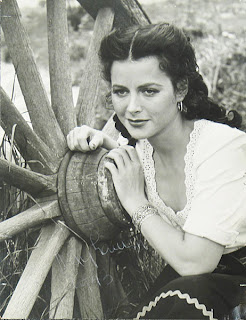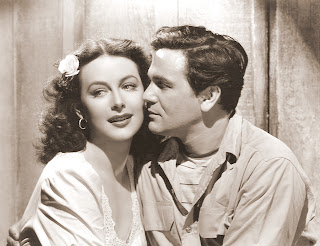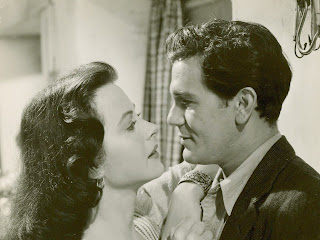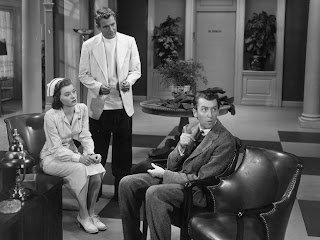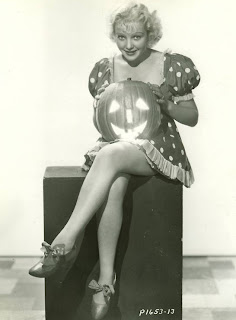"Force of Evil" (1948) directed by Abraham Polonsky (starring John Garfield, Thomas Gomez and Marie Windsor)
 "In their up-from-nothing lawyer who gets himself in too deep on the moral excuse that he is doing it for his brother, Mr. Polonsky and Mr. Wolfert have some real things to show about the practical operation of the psychology of crime. They do it in startling situations and in graphic dialogue, in shattering cinematic glimpses and in great, dramatic sweeps of New York background. New to the business of directing, Mr. Polonsky here establishes himself as a man of imagination and unquestioned craftsmanship. True, he was very fortunate in having John Garfield play the young lawyer in the story, for Mr. Garfield is his tough guy to the life. Sentient underneath a steel shell, taut, articulate —he is all good men gone wrong.
"In their up-from-nothing lawyer who gets himself in too deep on the moral excuse that he is doing it for his brother, Mr. Polonsky and Mr. Wolfert have some real things to show about the practical operation of the psychology of crime. They do it in startling situations and in graphic dialogue, in shattering cinematic glimpses and in great, dramatic sweeps of New York background. New to the business of directing, Mr. Polonsky here establishes himself as a man of imagination and unquestioned craftsmanship. True, he was very fortunate in having John Garfield play the young lawyer in the story, for Mr. Garfield is his tough guy to the life. Sentient underneath a steel shell, taut, articulate —he is all good men gone wrong. Beatrice Pearson is something of a lucky feature, too. With her innocent, worldly demeanor, her shyness yet forwardness, too, and a voice that would melt a pawnbroker, she points up the pathos in the tale". Source: movies.nytimes.com
Beatrice Pearson is something of a lucky feature, too. With her innocent, worldly demeanor, her shyness yet forwardness, too, and a voice that would melt a pawnbroker, she points up the pathos in the tale". Source: movies.nytimes.com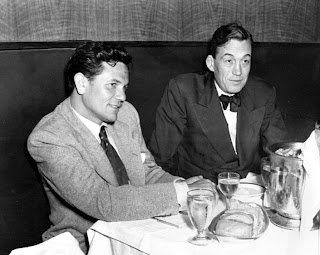 John Garfield and John Huston at the Stork Club
John Garfield and John Huston at the Stork Club "John Huston had been working on the "Treasure of the Sierra Madre" script for six years, before World War II was declared and he directed his great war documentaries, 'The Battle of San Pietro' and 'Let There Be Light'. When he started writing in 1941, Warner Brothers Studio had envisioned it for their three leading tough guys, George Raft, Edward G. Robinson and John Garfield. By the time filming started, Humphrey Bogart was the studio's biggest star, and he inherited the riches. John Huston plays a bit as the American that Bogart is always pestering for the price of a meal. Ann Sheridan, in heavy make-up supposedly played a whore in the background of one of the scenes as a good luck gesture". Source: www.moviediva.com
"John Huston had been working on the "Treasure of the Sierra Madre" script for six years, before World War II was declared and he directed his great war documentaries, 'The Battle of San Pietro' and 'Let There Be Light'. When he started writing in 1941, Warner Brothers Studio had envisioned it for their three leading tough guys, George Raft, Edward G. Robinson and John Garfield. By the time filming started, Humphrey Bogart was the studio's biggest star, and he inherited the riches. John Huston plays a bit as the American that Bogart is always pestering for the price of a meal. Ann Sheridan, in heavy make-up supposedly played a whore in the background of one of the scenes as a good luck gesture". Source: www.moviediva.com Ann Sheridan and John Garfield as Goldie West and Johnnie Bradfield in "They Made Me a Criminal" (1939)
Ann Sheridan and John Garfield as Goldie West and Johnnie Bradfield in "They Made Me a Criminal" (1939)"They Made Me a Criminal" (1939) starring John Garfield, Claude Rains, Ann Sheridan and Gloria Dickson, directed by Busby Berkeley
 John Garfield was one of those actors whose offscreen activities mirrored his on-screen persona: he was uneducated, didn't always think things out too clearly, loved women (too much, if such a thing is possible) and adhered to his own personal moral code.
John Garfield was one of those actors whose offscreen activities mirrored his on-screen persona: he was uneducated, didn't always think things out too clearly, loved women (too much, if such a thing is possible) and adhered to his own personal moral code. In September 1942, Warner Bros announced the purchase of "Deep Valley" a novel by Dan Totheroh, for Ann Sheridan, Humphrey Bogart and John Garfield. The story would languish on the studio's shelves until 1947, when it finally reached the screen with Ida Lupino, Wayne Morris and Dane Clark.
In September 1942, Warner Bros announced the purchase of "Deep Valley" a novel by Dan Totheroh, for Ann Sheridan, Humphrey Bogart and John Garfield. The story would languish on the studio's shelves until 1947, when it finally reached the screen with Ida Lupino, Wayne Morris and Dane Clark. John Garfield and daughter Katherine go riding in 1943
John Garfield and daughter Katherine go riding in 1943Also in 1942 Garfield was to court to have his name legally changed from Jacob Julius Garfinkle to John Jules Garfield. The change was done in order that daughter Katherine would have not trouble when she entered school.
 "He lived for so short a time, 39 scant years, that he's barely recalled now except by film reviewers who conjure his name in critical comparisons and historians who lament his early demise and wonder, "What if?" He coulda been a contender, though in reality was much more than that -the precursor to Brando and Clift and De Niro and Keitel, a tough guy who was softer than his coarse exterior allowed.
"He lived for so short a time, 39 scant years, that he's barely recalled now except by film reviewers who conjure his name in critical comparisons and historians who lament his early demise and wonder, "What if?" He coulda been a contender, though in reality was much more than that -the precursor to Brando and Clift and De Niro and Keitel, a tough guy who was softer than his coarse exterior allowed.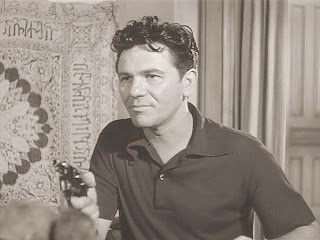 He was such a star that when he died in May 1952, in the apartment of a lover with whom he shacked up while separated from the wife and kids, his funeral was a mob scene --a Hollywood ending treated like an opening-night premiere, with all the attendant glitz and glamour befitting a Warner Bros. golden boy who wasn't the prettiest boy in the bunch, only the best.
He was such a star that when he died in May 1952, in the apartment of a lover with whom he shacked up while separated from the wife and kids, his funeral was a mob scene --a Hollywood ending treated like an opening-night premiere, with all the attendant glitz and glamour befitting a Warner Bros. golden boy who wasn't the prettiest boy in the bunch, only the best. Hedy Lamarr and John Garfield as Dolores and Danny in "Tortilla Flat" (1942) directed by Victor Fleming
Hedy Lamarr and John Garfield as Dolores and Danny in "Tortilla Flat" (1942) directed by Victor FlemingIf nothing else, the wonderful Turner Classic Movies documentary "The John Garfield Story", narrated by Garfield's daughter Julie and filled with testimonials by the likes of Joanne Woodward and Harvey Keitel and Martin Scorsese and a dozen other A-listers, serves to remind us of that much: Its subject may have vanished too soon, his demise hastened by a bad ticker and the leering goons of the House Committee on Un-American Activities, but John Garfield was a real immortal. Even if no one quite remembers why anymore". Source: www.dallasobserver.com
 Cecil Kellaway, John Garfield and Lana Turner in "The Postman Always Rings Twice" (1946)
Cecil Kellaway, John Garfield and Lana Turner in "The Postman Always Rings Twice" (1946) James M. Cain: Oh yes, I can remember the beginning of 'The Postman Always Rings Twice". It was based on the Snyder-Gray case, which was in the papers about then. Grey and this woman Snyder killed her husband for the insurance money. The big influence in how I wrote "The Postman Always Rings Twice" was this strange guy, Vincent Lawrence, who had more effect on my writing than anyone else. He had a device which he thought was so important —the “love rack” he called it. What he meant by the “love rack” was the poetic situation whereby the audience felt the love between the characters.
James M. Cain: Oh yes, I can remember the beginning of 'The Postman Always Rings Twice". It was based on the Snyder-Gray case, which was in the papers about then. Grey and this woman Snyder killed her husband for the insurance money. The big influence in how I wrote "The Postman Always Rings Twice" was this strange guy, Vincent Lawrence, who had more effect on my writing than anyone else. He had a device which he thought was so important —the “love rack” he called it. What he meant by the “love rack” was the poetic situation whereby the audience felt the love between the characters.INTERVIEWER: How did you react to Albert Camus's praise of your writing?
 CAIN: He wrote something about me —more or less admitting that he had patterned one of his books on mine, and that he revered me as a great American writer. But I never read Camus. In some ways I'm ignorant. In other ways I'm not. At fiction I'm not. But I read very little of it. When you write fiction, the other guy's book just tortures you —you're always rewriting it for him. You don't read it just as a reader; you read it as a guy in the business. I've read a great deal of American history. I don't write whodunits. I write love stories. The dynamics of a love story are almost abstract. The better your abstraction, the more it comes to life when you do it —the excitement of the idea lurking there. Algebra. Suspense comes from making sure your algebra is right. Time is the only critic. If your algebra is right, if the progression is logical, but still surprising, it keeps.
CAIN: He wrote something about me —more or less admitting that he had patterned one of his books on mine, and that he revered me as a great American writer. But I never read Camus. In some ways I'm ignorant. In other ways I'm not. At fiction I'm not. But I read very little of it. When you write fiction, the other guy's book just tortures you —you're always rewriting it for him. You don't read it just as a reader; you read it as a guy in the business. I've read a great deal of American history. I don't write whodunits. I write love stories. The dynamics of a love story are almost abstract. The better your abstraction, the more it comes to life when you do it —the excitement of the idea lurking there. Algebra. Suspense comes from making sure your algebra is right. Time is the only critic. If your algebra is right, if the progression is logical, but still surprising, it keeps. When they were making "Double Indemnity" in Hollywood, Billy Wilder complained that Raymond Chandler was throwing away my nice, terse dialogue; he got some student actors in from the Paramount school, coached them up, to let Chandler hear what it would be like if he would only put exactly what was in the book in his screenplay. To Wilder's utter astonishment, it sounded like holy hell. Chandler explained to Wilder what the trouble was that Cain's dialogue is written to the eye. That ragged right-hand margin that is so exciting and wonderful to look at can't be recited by actors.
When they were making "Double Indemnity" in Hollywood, Billy Wilder complained that Raymond Chandler was throwing away my nice, terse dialogue; he got some student actors in from the Paramount school, coached them up, to let Chandler hear what it would be like if he would only put exactly what was in the book in his screenplay. To Wilder's utter astonishment, it sounded like holy hell. Chandler explained to Wilder what the trouble was that Cain's dialogue is written to the eye. That ragged right-hand margin that is so exciting and wonderful to look at can't be recited by actors. Chandler said: Now that we've got that out of the way, let's dialogue it with the same spirit Cain has in the book but not the identical words. Wilder still didn't believe him. They got me over there, purportedly to discuss something else, but the real reason was that Wilder hoped I would contradict Chandler, and somehow explain what had evaporated. But, of course, I bore Chandler out, reminding Wilder I could write spoken stuff well enough, but on the page there just wasn't any room for talky climaxes. Chandler, who was an older man, was a bit irked by Wilder's omniscience, and he was pleased I backed him up". Source: www.theparisreview.org
Chandler said: Now that we've got that out of the way, let's dialogue it with the same spirit Cain has in the book but not the identical words. Wilder still didn't believe him. They got me over there, purportedly to discuss something else, but the real reason was that Wilder hoped I would contradict Chandler, and somehow explain what had evaporated. But, of course, I bore Chandler out, reminding Wilder I could write spoken stuff well enough, but on the page there just wasn't any room for talky climaxes. Chandler, who was an older man, was a bit irked by Wilder's omniscience, and he was pleased I backed him up". Source: www.theparisreview.org Lana Turner plays femme fatale Cora
Lana Turner plays femme fatale CoraCora/Kora: *k(o)-ra as a girl's name is pronounced KOR-ah. It is of Greek origin, and the meaning of Kora is "maiden". Can be traced back to classical mythology, though the modern form was coined by American writer James Fenimore Cooper in "The Last of the Mohicans" (1826), its proto-Germanic root, *khoraz (fem. *khoron) means “one who desires.”
 John Garfield as Charley Davis and Hazel Brooks as Alice in the boxing drama "Body and Soul" (947) directed by Robert Rossen
John Garfield as Charley Davis and Hazel Brooks as Alice in the boxing drama "Body and Soul" (947) directed by Robert Rossen "Body and Soul" is an experimental ethnography in the originary meaning of the term, in that the researcher is one of the socialized bodies thrown into the sociomoral and sensuous alembic of the boxing world. Boxing has declined tremendously from its glory days of the 20's or the 60's and it is only a shadow of its old self now.
"Body and Soul" is an experimental ethnography in the originary meaning of the term, in that the researcher is one of the socialized bodies thrown into the sociomoral and sensuous alembic of the boxing world. Boxing has declined tremendously from its glory days of the 20's or the 60's and it is only a shadow of its old self now.It’s hard for us to imagine how central it was to national life half a century ago, when a heavyweight championship fight brought the whole society to a complete standstill. The first reason for this is the general transformation of the life of the working classes, with the marginalization of hard manual work, the improvement in the standards of living, and the generalization of schooling as a means of access to even unskilled jobs: it has nearly dried up the supply of volunteers for the pugilistic front.
 Secondly, boxing occupies a lowly position at the bottom of the hierarchy of athletic avocations in the United States: it is something of a pariah sport, practiced mostly by those who have failed at other sports. It is not integrated into the normal academic courses: you cannot get a fellowship to go to college by boxing. Boxing is the quintessential body craft: you work on your body, to produce a new, skilled, body capable of withstanding and giving punishment in the ring.
Secondly, boxing occupies a lowly position at the bottom of the hierarchy of athletic avocations in the United States: it is something of a pariah sport, practiced mostly by those who have failed at other sports. It is not integrated into the normal academic courses: you cannot get a fellowship to go to college by boxing. Boxing is the quintessential body craft: you work on your body, to produce a new, skilled, body capable of withstanding and giving punishment in the ring. If you are small and stubby, with short arms and a strong upper body, you are tailormade for becoming what the lingo calls a “slugger” who is willing to take punches in order to walk up close to his opponent and fight from inside. But if you are lightly built, with a lithe torso, thin legs and long arms, then you’ve got to be what specialists call a “boxer” in the sense of technician who punches at a distance and avoids fighting by moving around and keeping his opponent at bay with straight jabs and right hands. As a rule, sluggers or counter-punchers have much shorter careers than “boxer-punchers” because they absorb a lot more blows and their bodies wear down much quicker. And they are also more prone to suffering long-term physical damage (medical studies show that dementia pugilistica, the “punch-drunk” syndrome, affects primarily sluggers and brawlers). —“Busy Louie” in the Ring: A Sociologist Among Prizefighters - An interview with Loïc Wacquant
If you are small and stubby, with short arms and a strong upper body, you are tailormade for becoming what the lingo calls a “slugger” who is willing to take punches in order to walk up close to his opponent and fight from inside. But if you are lightly built, with a lithe torso, thin legs and long arms, then you’ve got to be what specialists call a “boxer” in the sense of technician who punches at a distance and avoids fighting by moving around and keeping his opponent at bay with straight jabs and right hands. As a rule, sluggers or counter-punchers have much shorter careers than “boxer-punchers” because they absorb a lot more blows and their bodies wear down much quicker. And they are also more prone to suffering long-term physical damage (medical studies show that dementia pugilistica, the “punch-drunk” syndrome, affects primarily sluggers and brawlers). —“Busy Louie” in the Ring: A Sociologist Among Prizefighters - An interview with Loïc Wacquant Disc 1, side A: The Maltese Falcon Disc 1, side B: The Big Sleep Featurette The Big Sleep Comparisons 1945/1946 with UCLA archivist Robert Gift analyzing differences between the movie's two versions Disc 2, side A: Dial M for Murder
Disc 1, side A: The Maltese Falcon Disc 1, side B: The Big Sleep Featurette The Big Sleep Comparisons 1945/1946 with UCLA archivist Robert Gift analyzing differences between the movie's two versions Disc 2, side A: Dial M for MurderFeaturettes: Hitchcock and Dial M, 3-D: A Brief History
 Disc 2, side B: The Postman Always Rings Twice (1946), Documentary profile: The John Garfield Story, Introduction by historian Richard Jewell, Behind-the-scenes Image gallery
Disc 2, side B: The Postman Always Rings Twice (1946), Documentary profile: The John Garfield Story, Introduction by historian Richard Jewell, Behind-the-scenes Image gallery Ida Lupino as Stella Goodwin and John Garfield as Harold Goff in "Out of the Fog" (1941) directed by Anatole Litvak
Ida Lupino as Stella Goodwin and John Garfield as Harold Goff in "Out of the Fog" (1941) directed by Anatole LitvakWhen Barbara Stanwyck turned down the role of Stella in "Out of The Fog" (1941) directed by Anatole Litvak (written by Robert Rossen, Jerry Wald & Richard Macaulay, based on Irvin Shaw's play "The Gentle People"), Ida Lupino jumped at it. Producer Henry Blanke asked George Raft to play the heavy, but he declined. Bogart asked for the role, but Ida Lupino used her influence and Blanke agreed that her pal John Garfield would play the smooth-talking hoodlum Harold Goff.
 Filming "The Big Knife" (1955) directed by Robert Aldrich (based on a stage play written by Clifford Odets inspired by John Garfield - Odets's wife Bette Grayson supposedly slept with Garfield in real life), every scene was a heart-rendering experience for Ida (playing Marion Castle); the similarity between the film's character Charles Castle (Jack Palance) who commits suicide, and Garfield's downfall was emotionally upsetting to her. Ida told Aldrich the last scene gave her an eerie child (on screen, she reacted to her husband's suicide with a shattering scream).
Filming "The Big Knife" (1955) directed by Robert Aldrich (based on a stage play written by Clifford Odets inspired by John Garfield - Odets's wife Bette Grayson supposedly slept with Garfield in real life), every scene was a heart-rendering experience for Ida (playing Marion Castle); the similarity between the film's character Charles Castle (Jack Palance) who commits suicide, and Garfield's downfall was emotionally upsetting to her. Ida told Aldrich the last scene gave her an eerie child (on screen, she reacted to her husband's suicide with a shattering scream). Ida Lupino & John Garfield in "Out of the Fog" (1941)
Ida Lupino & John Garfield in "Out of the Fog" (1941)Exiled from Hollywood, Garfield had come back to his theatrical origins and played 'The Big Knife', 'Peer Gynt' and 'Golden Boy'. Garfield had sent Ida tickets to see him onstage. She arrived at his apartment with a writer friend from the New York Times for a toast before the performance. When Garfield opened the door of his dressing room, Ida was taken aback by his haggard appearance. Garfield prepared cocktails. He pointed to a basket of flowers, champagne and glasses. Ida read his note: "To my favorite sister. Sorry, I'm not going to make it tonight but I've always loved you, kid". Ida was perplexed.
 Ida wanted to hire John Garfield for her company but felt it was hopeless. Howard Hughes would never permit such a controversial actor to work at RKO. The heart condition that had prevented him from performing the last evening Ida saw him soon took his life.
Ida wanted to hire John Garfield for her company but felt it was hopeless. Howard Hughes would never permit such a controversial actor to work at RKO. The heart condition that had prevented him from performing the last evening Ida saw him soon took his life.—from "Ida Lupino: A Biography" (2000) by William Donati
 John Garfield with Ida Lupino
John Garfield with Ida Lupino "'My father once said to me, 'You're born to be bad', she recalled. 'And it was true. I made eight films in England before I came to America, and I played a tramp or a slut in all of them'." —Ida Lupino, The Hollywood Reporter (August 7, 1995).
"'My father once said to me, 'You're born to be bad', she recalled. 'And it was true. I made eight films in England before I came to America, and I played a tramp or a slut in all of them'." —Ida Lupino, The Hollywood Reporter (August 7, 1995). "Her films [as a director] display the obsessions and consistencies of a true auteur. What is most interesting about her films are not her stories of unwed motherhood or the tribulation of career women, but the way in which she uses male actors: particulary in "The Bigamist" and "The Hitchhiker" (both 1953), Ida Lupino was able to reduce the male to the same sort of dangerous, irrational force that women represented in most male-directed examples of Hollywood film noir." —Richard Koszarski in "Hollywood Directors 1914-40" (Oxford University Press, 1976)
"Her films [as a director] display the obsessions and consistencies of a true auteur. What is most interesting about her films are not her stories of unwed motherhood or the tribulation of career women, but the way in which she uses male actors: particulary in "The Bigamist" and "The Hitchhiker" (both 1953), Ida Lupino was able to reduce the male to the same sort of dangerous, irrational force that women represented in most male-directed examples of Hollywood film noir." —Richard Koszarski in "Hollywood Directors 1914-40" (Oxford University Press, 1976)


